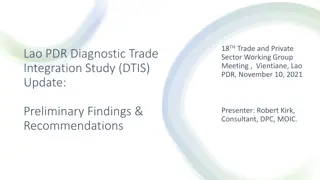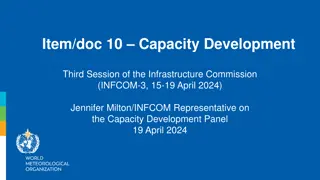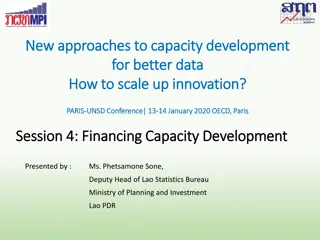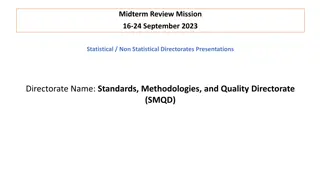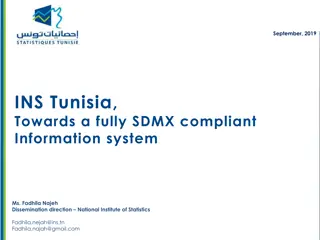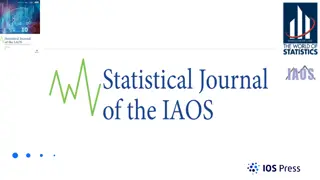Workshop on New Approaches to Statistical Capacity Development in Lao PDR
This workshop, hosted by PARIS21 and UNDP, focuses on enhancing statistical capacity development in Lao PDR. It covers topics like successful capacity development programs, partnerships for national statistics development, and prioritizing needs versus international requirements. The Lao Statistics System, coordination roles, and key factors in capacity development are highlighted through country perspectives and presentations. Various levels of capacity building and institutional strategies are discussed to improve statistical quality and workforce skills.
Download Presentation

Please find below an Image/Link to download the presentation.
The content on the website is provided AS IS for your information and personal use only. It may not be sold, licensed, or shared on other websites without obtaining consent from the author. Download presentation by click this link. If you encounter any issues during the download, it is possible that the publisher has removed the file from their server.
E N D
Presentation Transcript
WORKSHOP ON NEW APPROACHES TO WORKSHOP ON NEW APPROACHES TO STATISICAL CAPACITY DEVELOPMENT, STATISICAL CAPACITY DEVELOPMENT, 11 11- -12 December 2017. 12 December 2017. HOSTED BY PARIS21 AND UNDP HOSTED BY PARIS21 AND UNDP Phetsamone Sone Deputy Head, Lao Statistics Bureau Ministry Of Planning and Investment
Outline of presentation Outline of presentation Country perspectives Country perspectives Questions: 1. What makes capacity development programmes successful? 2. How can partnerships support the development of national statistics? 3. How do you prioritise between national statistical needs and international requirements?
Introduction Introduction context of the National context of the National Statistics System in Lao PDR Statistics System in Lao PDR The Lao Statistics System is a decentralized system: a. Vertical : LSB, provincial and district statistics center b. Horizontal : Statistics division /units of Line Ministries Key National Lead Producers : a. Lao Statistics Bureau ( LSB): National Accounts, Price, Poverty , Population and ( and extends to environment statistics) Real sector b. Ministry of Finance (MOF) : Government Financial Statistics Financial Sector c. Bank of Lao PDR ( BOL) : Balance of Payment , Monetary Survey External and Monetary d. Other Line Ministries Economic and Social Statistics include ICT statistics. e. Others key stakeholders The System still reliant on administrative sources for much of our statistical production, despite censuses and national sample surveys conducted on annual, five and ten years interval.
LSS Coordination Roles and Collaboration between NSS Government Vertical organizational network Horizontal organizational network Ministry of Planning and Investment All Ministry Lao Statistics Bureau Ministry/ agency Statistics Centre Central levels Statistics Division of Province Province Statistics Division Province Statistical Centre Provincial levels District Statistical Centre District Statistics Unit District levels Village Statistics unit Central establishment Statistics unit Village levels Report System Adviser official 4
What makes capacity development What makes capacity development programmes programmes successful? successful? National National Perespctive Perespctives s Varying levels Individual level staffs Team /Department, Organization LSB and others Key producers System-Institutional level Human Resource Capacity building implementation plan Quality recruitment ( educational background and interest ); job description and function. Sufficient budget support the implementation and recourse persons, qualified TOT and good training facilities ,ICT Statistics Decree 1990, Statistics law ( 2010) New revision statistics law 2017; National HR Strategy ,2025. Skill and knowledge transfer and absorptive capacity Technical skill, commitment and hard work , open mind creative thinking Working environment and encouragement, incentive support from Management and team work; Language knowledge; Modality and Approaches of professional ( local context) training delivery Statistics and General Education ( data- statistics literacy ); Statistics Collage / sub faculty at National University Effective program management and adaptation to working culture Core staffs , middle management training; Planning; Management training on organizing and control to achieve the results ( job and attachment training ) Development of an ethics of team working to enable greater collaboration and knowledge sharing cross LSB and Line Ministries and Provinces; Improvement of organization structure and working mechanism . Career Development Program compare to other organization in the system.
What makes capacity development What makes capacity development programmes programmes successful? successful? National National Perespctive Perespctives s Individual level staffs Organizational LSB and others Key producers System-Institutional level Coordination, Collaboration and Communication ( Producers , Users and other key stakeholders ) Understanding and clear role and responsibilities and outputs to be produced ( Demand and Supply driven ) Interagency coordination MOU or agreement on statistics production / indicators Close Monitoring and Good Result Assessments High level discussion and appreciation on NSS coordination ( data production, data sharing and dissemination .) M&E frame work for result monitoring Financial resources Qualified and capable finance staffs Appropriate resources GAP assessment; Plan for budget for 3- 5 years; Rationalize Annual work plan to MPI and MOF on time thru the budgetary process; Transparency and accountability . Government Budget support to statics integrated in NSEDP , Monitoring and Evaluation Frame Work ; SD NSS 2006-2010; SD NSS 2010-2020 SD NSS revision 2016-2015 and vision 2030; Country Partnership Framework of Cooperation ( ODA/ grant and Loan )
What makes capacity development What makes capacity development programmes programmes successful? successful? National National Perespctive Perespctives s Individual level staffs Organizational LSB and others Key producers System-Institutional level Political support Demand Driven Well understood how the system works , build good networking and relationship at various levels, good commination and quick reaction LSB became a sub-ministry ( under Ministry of Planning and Investment ) in 2010, head of LSB is equivalent to Vice Minister; 2017 revision Law : LSB Head position is Vice Minister of MPI. Alight and integrate Statistics Development as a foundation and cross cutting of development agenda; Demand driven : National and international ( NSEDP with MSDG and SDGs integration ) M& E framework. SD NSS 2016-2025 approved by PM with the commitment for support the operational national census and surveys . However , funding GAP still to be mobilized.
How can partnerships support the development of How can partnerships support the development of national statistics? national statistics? Key Development Partners and International organization ( Bilateral and Multilateral) support statistics capacity building and strengthening the NSS in Laos: Regional projects : ADB, IMF, EU-ASEAN COMPASS National: WB LAOSTAT ( Mix mode PPP Twining approach GOPA , Istat.and Teach ) , UNDP, UNICEF, UNFPA, SDC, PARIS 21, FAO, WFP, WHO Bilateral : Korea Statistics Office (KSO) and STATEC Luxembourg, People s Republic of China(Population census 2015) Sida (1992-2010). ADB National capacity building project ( 2011-2013). Time : 1-5 years ( 3 years ) Nature modality support: Technical Assistant and Support to data collection and operating cost of statistical production and dissemination as well as infrastructure
Lesson learned Upside: Project Design Clear PDO Alignment of the Project with the SDNSS The Project is well focused and prioritized with clear result indicators Project Management and implementation structure Strong GOL/LSB ownership PSC to provide strategic guidance and oversight on project performance NICT (PIU) to manage daily work activities M & E and quarterly project progress review meeting Twining (CSTA) provides good and timely TA support ( key and none key experts ) with specialized expertise - high quality of professional and transfer knowledge to the teamwork. Mobilize and Coordinates by CSTA - GOPA releases LSB of Administrative burden of recruiting and managing individual consultants. Task Team leader (TTL and experts) provides close and timely support on project implementation and problems solving
Lesson learned Downside: Lengthy project preparation (more than 14 months) caused LAOSTAT implementation time to reduce from 5 to 4 years Slow start due to weak implementing capacity of LSB/SMAs and difficulty in procuring FM and procurement consultants It took long time and was difficult to build ownership at sub- implementing unit level (departmental) from LSB and SMAs to increase their commitment Inexperienced NICT has difficulty in speeding up project activities during the first two years Twining: Issues of mission timing and availability of LSB staffs to work with CSTA consultants; language barrier also.
How can partnerships support the development of How can partnerships support the development of national statistics? national statistics? Support and involve in the preparation and support the NSDS process and its alignments include the external assessment. Support the enforcement and implementation ( Funding support proportionally cover the cost of Technical assistance and operating costs where possible / applicable ) . Fund raising Strategies and helping countries for better donor coordination and interagency collaborations. Assist countries prepare advocacy strategies and its enforcement, co-funding ( where possible ) organize Reputation / Visibility events , data literacy. Support for longer term 5-10 years as to build and strengthen the data ecosystem. Support and build the management capacity at various level as to enhance and increase National Ownership, build trust in the project and program implementation and management. Assist countries in learning and adopting / adapting the different tools in tracking the progress of the implementation of projects or programs
How do you How do you prioritise needs and international requirements? needs and international requirements? prioritise between national statistical between national statistical How National and International agenda Development Needs are integrated Five Years Socio-Economic Development Plan (NSEDP) Central Planning Economy until 1986. NEM since 1986 (National Socio Economic Planning, Sectoral planning, Specific Projects and National Programs) 6th , 7th five year Plan integrated MDGs and current 8th NSEDP 2016-2020 is integrated the SGDs and will continue / gradually in the process of 9th and 10th NSEDP Statistical need prioritized : Based on M&E framework of NSEDP NSEDP, Sectoral , provincial development targets that required to monitor. International / regional integration : UNSD, UNESCAP, ASEAN, IMF, ADB . MDGs, LSDc, SDGs 2030 Others demands from users
How do you How do you prioritise needs and international requirements? needs and international requirements? prioritise between national statistical between national statistical SD NSS 2006-2010, 2010 -2020 and currently updated 2016-2025. A live framework official indicators and outputs is defined and determined based on above mentioned needs. Data sources ( traditional ) + new data sources + technology defined. In addition to SD NSS 2016-2025 , LSB with the support of CTSA produced: Institutional Capacity Building Program 2016-2020 HR strategy 2016-2020 ICT strategy / Master Plan 2016-2020 Dissemination strategy 2016-2020 Lao Quality Assurance Frame Work The framework prepared and taken into account of international demand and methodology standard as develop and strengthen the LSB and NSS in a successful way.
4 Pillars for developing Laos NSS 4 Pillars for developing Lao s NSS Pillar 1: Developing the LSB leadership role in the coordination of the National Statistics System Pillar 2: Strengthening organisation development Pillar 3: Modernising the statistical infrastructure Pillar 4: Improving the service to user s (and increasing trust in official statistics) .



